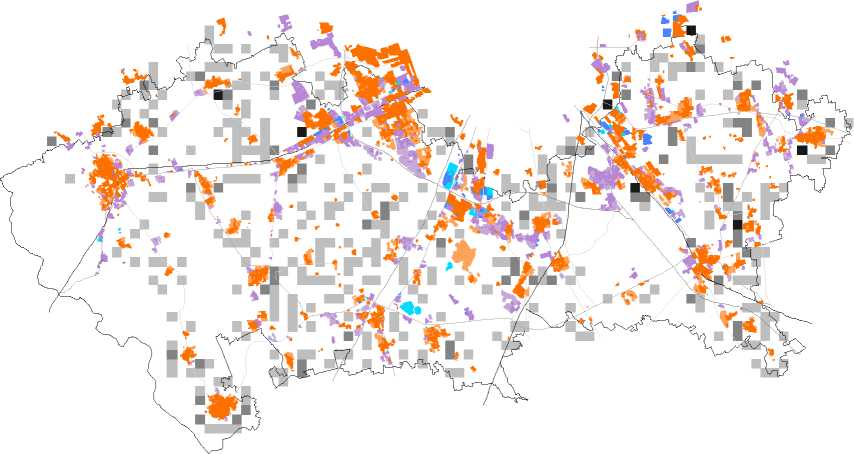|
80 kmq 60 kmq |
RESIDENTIAL 2008 |
40 kmq 30 kmq |
INDUSTRIAL „„„„ 2008 |
8 kmq 6 kmq |
COMMERCIAL 2008 |
|
40 kmq |
^^-''∙'1994 |
20 kmq |
/-*1994 |
4 kmq | |
|
*1980 |
*1980 |
• 1994 | |||
|
20 kmq |
10 kmq |
2 kmq |
∙l980 | ||
|
kmq |
— |
kmq |
— |
kmq |
— |
Figure 8 - The surface growth for each land use
and, surprisingly, along the roads; this result is unexpected because, as said earlier, the
record does not include information about road accessibility.
Moreover, the new residence seems to be attracted by the proximity to other activities
(industry and commerce). Indeed, this spatial feature characterizes the urban quality of
the Italian historical cities and villages and holds particularly in this territory.
New productive settlements will be based mainly around the existing large industrial
areas, showing a location criterion mainly driven by agglomeration economies. Such
behaviour characterizes also the larger new settlements predicted from the NN for
commerce, which, in the considered area, are clustering around new development poles
near the highway and far from the urbanised areas.
On the contrary, small and diffused expansions in industry and commerce will take
place in and around the existing urban areas, improving the urban mix and urban
agglomeration economies.
What is worthwhile to note is that the SANN findings, in terms of spatial patterns, are

Figure 9 - the predicted residential growth at 2008 (grey tones)
15
More intriguing information
1. The name is absent2. Nonparametric cointegration analysis
3. The name is absent
4. INTERACTION EFFECTS OF PROMOTION, RESEARCH, AND PRICE SUPPORT PROGRAMS FOR U.S. COTTON
5. Social Cohesion as a Real-life Phenomenon: Exploring the Validity of the Universalist and Particularist Perspectives
6. TOMOGRAPHIC IMAGE RECONSTRUCTION OF FAN-BEAM PROJECTIONS WITH EQUIDISTANT DETECTORS USING PARTIALLY CONNECTED NEURAL NETWORKS
7. Connectionism, Analogicity and Mental Content
8. Pricing American-style Derivatives under the Heston Model Dynamics: A Fast Fourier Transformation in the Geske–Johnson Scheme
9. The name is absent
10. Estimating the Economic Value of Specific Characteristics Associated with Angus Bulls Sold at Auction